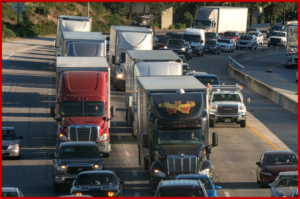The California Air Resources Board has approved a ‘smog check’ regulation for medium- and heavy-duty trucks and buses. The program is projected to yield ~$75 billion in health benefits, prevent 7,500 air-quality related deaths and 6,000 hospitalizations and emergency room visits from 2023 to 2050. These benefits are 18 times the estimated cost of the program at $4 billion.
These heavy-duty vehicles with a gross vehicle weight rating (GVWR) greater than 14,000 pounds consist of only 3% of all vehicles on California roads. However, they are responsible for more than 50% of nitrogen oxides and fine particle diesel pollution from all mobile sources in the state.
Covered are 1 million heavy-duty trucks and buses operating in California. The twice-a-year inspections will ensure that the emissions control systems maintain the same efficiency as the vehicle ages. The Board also directed a four-times per year testing frequency for trucks with on-board diagnostics to be phased in over time. By 2037, the program is estimated to deliver reductions of 82 tons per day of NOx and fine particle diesel pollution.
“This first-in-the-nation program will prevent trucks and buses from emitting unhealthy pollutants from their engines for the life of the vehicle,” said CARB Chair Liane Randolph. “This common-sense measure will provide the pollution reductions we urgently need to achieve federal air quality standards and deliver cleaner air to impacted communities near ports, freeways, and warehouses.”
The new program implements SB 210, authored by Senator and ex-officio Board member Connie Leyva in 2019, directing CARB to develop and implement a new, comprehensive Heavy-Duty Inspection and Maintenance program to control emissions more effectively from non-gasoline on-road heavy-duty vehicles. It will also include independent owner/operators who were exempt from the current program of periodic smoke inspections.
The Heavy-Duty Inspection and Maintenance program will roll out a statewide network of roadside emission monitors to screen for high emitting trucks, starting with the San Joaquin Valley and South Coast and expanding over time. It will also require vehicles with a GVWR greater than 14,000 pounds operating in California to perform periodic testing and submit the data to CARB. As with passenger cars and light-duty trucks, California registration of these heavier vehicles will require passing the inspection. Unlike light-duty smog checks, however, there is no requirement to go to a ‘brick and mortar’ heavy-duty smog check station.
Heavy-duty vehicle owners will be able to complete the required test and deliver the information remotely without having to travel to designated testing locations. For telematics users, an onboard diagnostics (OBD) inspection that draws emissions control performance data from the vehicle’s internal computer, an inspection can be completed automatically without taking the vehicle out of operation. OBD systems have been required by CARB on heavy-duty vehicles since 2013. Older heavy-duty vehicles without on-board diagnostic systems would continue the current opacity testing requirements with an added visual testing component, twice each year.
The Heavy-Duty Vehicle Inspection Program will continue to augment the new testing requirements with inspections and testing randomly carried out at border crossings, California Highway Patrol weigh stations, fleet facilities and randomly selected roadside locations.



Pingback: Clean Truck, Bus CALSTART Incentives Available at CARB | AutoInformed
Pingback: CARB – New Diesel Regs Cost Effective, Lobbyists Wrong | AutoInformed